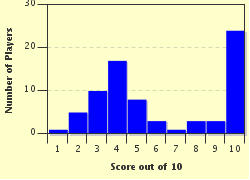Quiz Answer Key and Fun Facts
1. Examples of knitting have been found which date back to the fourth century, but the first knitting guild was not founded until 1527. Who were the members?
2. Quilting was another textile manufacturing process that was a home industry. It was born out of frugality and necessity. The oldest known North American Quilt has what date embroidered on it?
3. By the 1700s the big textile mills in Britain were in full production and attracting workers from all over the world. Mice and rats were a problem, and they had a solution we would recognise today. What was it?
4. Silk, that most beautiful of fabrics, comes from worms, but which part of the worm produces the silk threads?
5. New Zealand is one of the largest producers of wool in the world, and the sheep easily outnumber the people. This wasn't always the case. The first sheep were sent to New Zealand from Britain in the late 1700s. How many were there?
6. All textile work done at home was done by hand, and this did not start to change until the late 1700s. Which British inventor patented the first workable sewing machine?
7. With the advent of machines hand made textiles became a craft. Who, in 1913, sent three hooked rugs to a craft store, which started her business "Cottage Craft Woollens"?
8. The advent of nylon took the textile and fashion world by storm. Patented by DuPont and introduced at the New York World's Fair it caused a sensation. What was the first nylon item available?
9. In the late 1950s and 1960s man made materials were used everywhere. Which fabric was developed by ICI Laboratory and named after the valley in which they had their headquarters?
10. In the 1990s, after decades of man made fibres, the fashion industry re-discovered natural fabrics, especially cotton. Which of the following countries is a large cotton producer?
Source: Author
StarStruck60
This quiz was reviewed by FunTrivia editor
bloomsby before going online.
Any errors found in FunTrivia content are routinely corrected through our feedback system.

